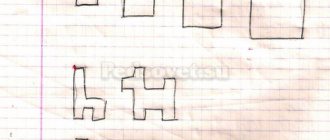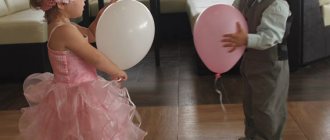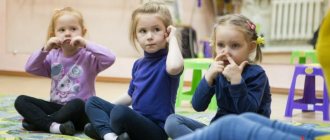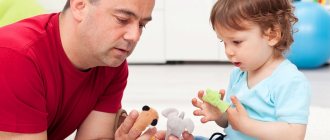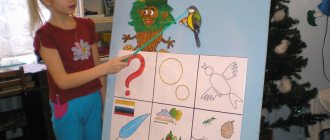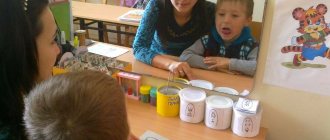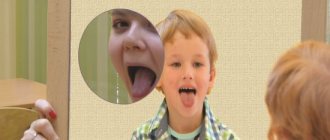Play gymnastics for children 2-3 years old
Physical education for children of any age should include gymnastics.
Little fidgety 2-3 year olds are not always ready to do boring exercises, but if you turn the activity into a game, it will bring benefits and pleasure. Don't forget that physical activity with your child is an excellent way to spend time together and communicate. We suggest looking at examples of play gymnastics for young children. At the end of the article, we have prepared for you a checklist “Logic and thinking games for children under 5 years old.” Download it and find out the most interesting intellectual games for children from 2 to 5 years old!
When should you not exercise?
Surely many people know that any exercise is contraindicated for children who have recently undergone a preventive vaccination. But this, it turns out, is far from the only reason why gymnastics will have to be cancelled.
There are a number of diseases for which gymnastics are prohibited:
- any conditions accompanied by fever and fever;
- various inflammatory lesions of the skin (including purulent ones), as well as muscles, bones, lymph nodes or subcutaneous tissue;
- atrophy;
- bone diseases, accompanied by pain and fragility;
- acute arthritis, tuberculosis of bones or joints;
- acute nephritis or hepatitis;
- rickets;
- congenital heart defects;
- hemorrhagic diathesis, hemophilia;
- active tuberculosis;
- large hernias (inguinal, umbilical, scrotal, femoral).
Sometimes we cannot “by eye” determine whether a child has a particular disease. Therefore, before starting active physical activities with him, consult your pediatrician.
Reach out to mom
Benefit: Works the abdominal muscles.
Items: gymnastic stick.
During everyday games, even the most active kids do not always use their abdominal muscles, so it is important to include this element in play gymnastics for kids. The child performs this exercise while lying on his back. If possible, with straightened legs, the baby should reach the gymnastic stick or simply your palm. Initially, do not raise the stick or hand too high from the floor. Focus on the baby's physical capabilities. Raising your legs a little and holding in this position strengthens your abs well.
LiveInternetLiveInternet
Fun gymnastics for children from 1 to 3 years old. Gymnastics for kids
At the age of two or three, children love to imitate adults. Use this quality for useful purposes. You will have to do the exercises together. Just show your child a good example, and he will definitely do everything like mom or dad. “Do as we do, do better than us”! - let these words become the motto of your family.
Gymnastics for kids should not turn into complex strength exercises, push-ups, abdominal swings or acrobatic tricks. It must be carried out for 5-10 minutes, and only in a playful way. Otherwise it won't work. At this age, it is difficult to keep a child’s attention; he needs to be captivated by something. Use and play on topics that are close and understandable to the baby. Don't give all the exercises at once. Two or three are enough for the baby to play and at the same time learn some new motor skills.
CHARGING FOR THE SMALLEST
Get some sunshine. Tell your child that the sun is shining directly above his head (you can hold a yellow balloon in your hands). Ask him to get the sun. He will stretch his arms up and rise on his toes. Here's exercise number 1.
On toes and heels . Ask your child: how can he walk on his toes and heels? Show me how to do it. Let your doll or favorite soft toy take part and show off their skills.
Squats. How to teach a child to squat? Scatter different objects (or toys) around the room and ask your baby to bring them to you one at a time and put them, for example, in a box. The conditions of the game will “force” him to squat.
Bridge. This bridge is different from an adult one because it is performed in reverse. The baby should stand on his hands and feet, but not with his stomach, but with his back up. Make sure he straightens his knees. Look into the baby’s face and ask: “Who became our bridge?”
Little engine . Let the child get down on all fours and show how the locomotive rides. You can accompany the movements with the sounds: “chug-chug.” Mark the trajectory of the “locomotive” and let it try to reverse.
Airplane. Spread your arms out to the sides and fly around the room. Accompany your movements with the sounds of a flying airplane: “oo-oo-oo.”
Scissors . This is a classic exercise that we all know well. A child’s abdominal muscles are not yet strong enough to support their legs for a long time. He will have his own “scissors”. The main thing is effort!
Kitty. Have your baby get on all fours and arch his back up and down, like a cat. Don't forget to purr!
The bear is clubfooted . Ask your child: “How does the bear walk?” Let him show. Demonstrate the clumsy movements of a clubfoot.
Running and jumping. Sprinting for a two-year-old toddler will most likely end in a fall. Learn to run fast gradually. For good coordination of movements and balance, invite your baby to run between placed objects. After running, do some jumping. This won’t be too difficult: ask your child to show how a hare jumps.
PREVENTION OF FLAT FOOT. To prevent flat feet, do foot exercises.
◈ Sit your baby on the floor and invite him to be a monkey. Scatter various (small) objects around and ask the baby to collect them with his toes. Show me how to do it. The task will not be easy!
◈ Sit on the floor (on a soft surface) opposite each other, hold a towel (or clothing) between your legs and play tug of war.
◈ Sit on the floor, pass the ball to each other, pushing it with your feet.
◈ Let the baby raise his arms up, stand on his toes and walk several circles around the room. This exercise trains the muscles of the lower leg and foot well.
Let's move to the songs
If desired, any children's song can be used as musical accompaniment, as well as prompts for action when performing exercises. For example, this one:
Ah, in Africa the mountains are so high (we raise our hands up)
Ah, in Africa the rivers are this wide (we raise our arms to the sides)
Ahh, crocodiles, hippos, (clap our hands)
Ahh, monkeys, sperm whales,
Oh, and a green parrot (we wave our arms like birds).
Source
Poems for physical education for children
We clap our hands, clap, clap clap over our heads We stomp our feet, stomp, stomp raise our knees high Shake our heads head forward back move We raise our hands, we lower our hands raise, lower We squat low and straight we stand up squat and jump Hands down , on the side, clamp it into a fist. Hands up and into a fist, unclench to the side. Get up on your toes, squat and straighten up. Feet together, feet apart.
One, two - head up. Three, four - arms, legs wider. Five, six - sit down quietly.
Once, they waved their arms up, And at the same time they sighed, Two, three, they bent down and reached for the floor. And four - stood up straight and repeat first. We breathe in a lot of air. When bending, exhale in a friendly manner, but you don’t need to bend your knees. So that our hands don’t get tired, We’ll put them on our belts. Jumping like balls Girls and boys.
There is a forest on the mountain, making circular movements with your hands. It is neither low nor high. sit down, stand up, hands up. An amazing bird gives us a voice. eyes and hands up, stretch along the path two tourists were walking home from afar, walking in place They said: “We have never heard such a whistle before.” raise your shoulders
Let's raise our hands up - once above the nose, above the eyes. Keep your arms straight up, don't sway, don't tremble. Three - put your hands down, Stand still, don’t move around. Up one, two, three, four, down! We repeat, don’t be lazy! We will make turns. Do everything willingly. One - turn left, Two - now vice versa. So, without any haste, repeat 8 times. Hands on the belt, legs wider!
One - rise, pull yourself up Two - bend, straighten up Three - clap your hands three times, nod your head three times. Four - wider legs. Five - wave your arms. Six - sit down quietly at the table.
Five cheerful brownies on a festive night reveled too much. Standing on tiptoe, one spun in a waltz, and the other stumbled and bloodied his nose. The third jumped to the heavens and grabbed the stars from the sky. And the fourth stomped like a clubfooted bear. The fifth sang until he was hoarse, song after song. That night the brownies had a lot of fun.
Winter evening in the blue sky get up from the table The blue stars are lit, stand on your toes, stretch The branches are pouring blue frost, shaking your hands, slowly sit down on the snow-covered snow.
Pick up the toy
Benefit: working the back muscles.
Items: any small toys, cubes.
Children often play while sitting on the floor, which uses the shoulder muscles but not the back muscles. During gymnastics for children 2-3 years old, it is very important to pay attention to strengthening the muscles in this area of the body and legs. The easiest way to do this is by bending. You need to hold the child close to you and carefully fix his knees with your hand. Ask your baby to bend down and reach for a toy that is on the floor. You can pick it up, give it to mom, or put it in a box.
Introductory part
Morning exercises for a child of this age include from five to six exercises. They are designed exclusively for the baby, and he will be able to complete each of them. Exercises train specific muscle groups: 1. Shoulders and arms. 2. Muscles of the trunk. 3. Legs. 4. Feet. Charging is usually done gradually. First you need to start with preparing for the exercises. Then, after a short warm-up, the child moves on to completing tasks. And after that he gradually stops exercising - this happens at the final stage. Before you start exercising your child, you should think it through as much as possible. Remember, your task is to make sure your baby doesn’t get bored. To do this, morning exercises need to be done playfully. We also recommend that you select only those exercises that will be truly interesting to your baby. The maximum duration of morning exercises should vary from five to seven minutes. To get your child interested in training, we recommend starting your first lessons with exercises that he likes. For example, if your child frequently claps his hands and stomps, include these body movements in your program. The child will happily repeat them. And he won’t notice that, at the same time, he was forced to train. Always encourage your child during activities. If he manages to perform the exercises correctly, and at the same time he does not philander, then praise him. Say that he is great. This way the child will understand that mommy appreciates his diligence and work. Every movement you make should be accompanied by sounds. For example, if you tell your child to clap his hands, then accompany this with the appropriate “clap-clap.” If one of the exercises is stretching, then we recommend saying something like “stretch, stretch” during it. You can reinforce your child’s actions with any sounds. The main thing is that he hears you. And he understood that they were interacting with him. Also ask your child to repeat after you. With this, he will be able to develop respiratory organs.
I'm a little fish
Benefit: working the muscles of the shoulder girdle and interscapular muscles, strengthening the back.
Items: gymnastic stick.
During normal exercises, it is difficult to use the interscapular muscles, but they, together with other muscles, are responsible for the condition of the back. The following exercise comprehensively affects the back with the participation of the muscles of the shoulder blades and shoulder girdle. Ask your child to turn into a “little fish.” To perform the exercise, the baby must lie on his stomach. The arms and upper body rise, and the spine bends. At this age, the child cannot yet do such a deflection on his own, so it is optimal to perform the exercise with his hands resting on a gymnastic stick or simply on the hands of an adult. A slight deflection and delay in this position is enough.
Exercises for legs and feet
Mouse in a hole
.
For this exercise you will need a chair. Your child should hide behind it. And then start looking out from behind it. Pretending that he is a mouse coming out of his hole. To make it as interesting as possible for your child, we recommend voicing actions. For example, you can say “ku-ku!” Ball or grasshopper
.
During this exercise, the baby should jump and move sharply to the right and left. You need to jump at least fifteen and no more than twenty times. Raise your legs higher
! The baby needs to gradually raise his legs to the top. They must, however, be straight. There is no need to bend them. Doing this exercise is not easy. Especially at this age. Therefore, it will be enough for the child to do 5-6 repetitions.
I'm a little snake
Benefit
:
working the muscles of the back, legs, strengthening the spine
.
Items
:
bench, gymnastic stick or other imitation obstacle
.
Small children love to crawl and crawl under various obstacles. Such exercises comprehensively strengthen all the muscles of the body and have a particularly beneficial effect on the spine. To perform the exercise, you need to organize an obstacle about 40 cm high. This can be a bench, a stick, a stretched rope, or just the hands of an adult. The child, lying on his stomach, must crawl completely under the proposed obstacle. If at first it is difficult for your child to do this exercise, then raise the obstacle a little higher.
We walk along the path
Benefit
:
footwork, improved coordination of movements
.
Items: tapes, ropes or other objects to imitate the border of the path, rugs with
a ribbed surface.
The benefits of regular walking cannot be underestimated. Invite your child to walk along a small path about 15 cm wide. This exercise not only affects the leg muscles, but also helps to train proper walking and good coordination of movements.
To prevent flat feet, walking on ribbed and textured surfaces helps. For these purposes, you can find special mats or boards on sale.
Another useful exercise option is walking with high knees. Invite your child to imagine himself as a stork and walk around the room with him.
At the end of the article, we have prepared for you a checklist “Logic and thinking games for children under 5 years old.” Download it and find out the most interesting intellectual games for children from 2 to 5 years old!
List of exercises for morning exercises
We have selected a number of exercises for you that can be used while charging.
- Fast walk
. At the age of two to three years, babies do not yet know how to fully run. Therefore, the only thing you can ask them to do is walk at high speed. With this exercise your child will be able to:
1. Achieve improved brain activity. 2. Improve the circulatory system. 3. Learning to breathe correctly will make your breathing system stronger. 4. Stretch your muscles.
- March
. During this exercise, the child must march. Of course, he most likely will not have such grace as the military. But he should at least try to march this way. This exercise is performed for thirty to forty seconds. You can even come up with some verse with a clear beat. So that when pronouncing it, the baby stomps correctly. - Catching butterflies
. During this lesson, you need to send your baby to walk around the room. And tell him to catch imaginary butterflies in his hands, clapping loudly. With this exercise he will be able to develop his motor system while having fun at the same time. - Little engine
. This exercise is fun to do if you have several kids. But if you only have one child, you can play together. Your task with your baby is to form a snake. Take each other's shoulders and start moving around the room. The main thing is not to lift your hand from your shoulder.
We walk merrily
Benefit
:
improved coordination of movements
.
Objects: blocks, toys or other objects to simulate obstacles.
It is useful for children aged 2-3 years to do gymnastics, which includes exercises to develop coordination of movements. Arrange several low obstacles at a distance of about 40 cm from each other. When a child steps over such obstacles, many small muscles of the body are involved, but the main benefit occurs in the form of a positive effect on the coordination of the baby’s still awkward movements.
